Letters from Lodi
An insightful and objective look at viticulture and winemaking from the Lodi
Appellation and the growers and vintners behind these crafts. Told from the
perspective of multi-award winning wine journalist, Randy Caparoso.
The original Lodi Natives — the Plains Miwok
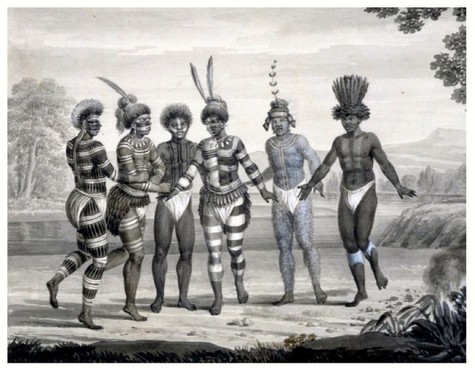
Early 1800s illustration of indigenous Plains Miwok, known for practicing body painting and tattooing
The original populace in the area we now know as the Lodi Viticultural Area were, of course, Native, or Indigenous, Americans. Who were they?
Perhaps a better question: Where were these people by the time the Treaty of Guadalupe Hidalgo — ending the Mexican-American War and turning Alta California over to the United States — was signed on February 2, 1848? Why were their lands free for the taking in the years immediately following the discovery of gold at Sutter's Mill, also in 1848, which unleashed a tsunami of settlers eager to put down roots in this new American state (California was admitted into the Union on September 8, 1850)?
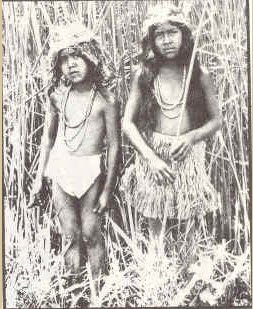
1800s photograph of Miwok children
The Anglo settlement near the banks of the Mokelumne River was originally called Mokelumne, and would not be renamed as Lodi until 1874. By that time, it had become something of a bustling agricultural community, thanks largely to a group of enterprising landowners and businessmen who in 1869 had persuaded Central Pacific Railroad to establish a depot near the corner of Sacramento and Pine Streets, where the landmark Lodi Arch would later be erected for the 1907 Tokay Carnival. This, with the completion of the Transcontinental Railroad in 1869, connected the tiny Mokelumne settlement to the entire country.
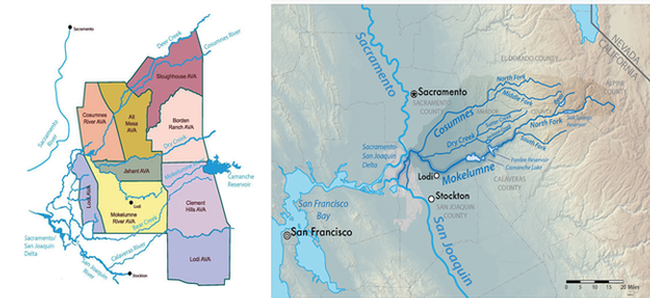
The Mokelumne River watershed — the homeland of the Plains Miwok — in proximity with the currently existing Lodi AVA (on left)
"Mokelumne" was a corruption of the words for "river" (mogul) and "people of" (one) spoken by the Plains Miwok tribe, also known as the Valley Miwok, who were once part of the largest group of indigenous people in the state of California. The U.S. Bureau of Indian Affairs recognized a total of 11 different Miwok tribes in California, of which the Plains Miwok were the most populous.
1769 is a date given for the "first contact" between the Miwok and people of European descent. Rough estimates put the total population of Miwok during that time at anywhere from 11,000 to 17,800, although the accuracy of these counts is questionable. There are an estimated 3,500 people of varying proportions of Miwok blood still living in California.
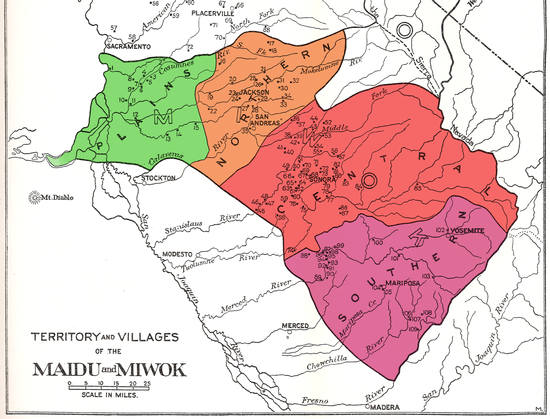
Early 1800s mapping of Miwok tribal lands falling in the San Joaquin and Sacramento Valleys from the Bureau of American Ethnology Handbook of the Indians of California
The Plains Miwok occupied the area, according to Ralph A. Clark (Lodi—Images of America), which the first European-blooded settlers found to be "an abundant paradise." This was a lush riparian environment dominated by grasslands and oaks, located in the vicinity of the Cosumnes, Mokelumne, and Calaveras Rivers, sandwiched between the foothills of the Sierra Nevada mountain range to the east and the freshwater marshland of the Sacramento-San Joaquin River Delta to the west.
The Plains Miwok dwelled in cedar bark teepees, and during colder months, in semi-subterranean "pit" houses, built as much as 15 feet into the ground. Their diets reflected their environment: acorns (made into flour, soups, and bread), buckeye nuts, mushrooms, hazelnuts, bulbs, roots, seeds, berries (including elderberry syrup), trout, salmon, shellfish, venison, elk, jackrabbits, squirrels, quail, snakes, the occasional mountain sheep and black bear, and even crickets, grasshoppers, caterpillars, and dried locusts.
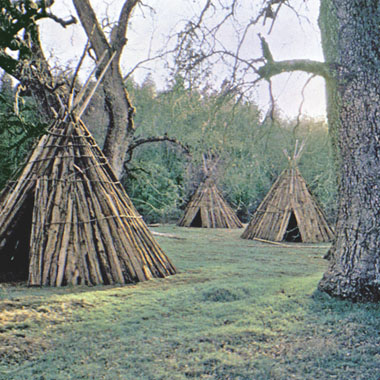
Recreated Plains Miwok teepees in Sacramento County
Information about how long the Miwok population lived in California is sketchy. Some still date the settlements back to the migrations from Asia approximately 20,000 years ago, coming over a Bering Strait Bridge. Other sources say the Miwok were descendants of Siberians who arrived about 3,000 years ago by sea. It is well documented that, at the end of the 1700s, the Miwok were living in small groups or tribes in numerous established communities. Evidently, domesticated dogs were common companions. Otherwise, they lived without any centralized governance (no politicians!) and didn't seem to need any.
Anthropologists have identified three other major branches of the Miwok that lived in parts of present-day Sacramento Valley, San Joaquin Valley, and the Sierra Nevada. Linguistically, there was a total of seven dialects identified as part of the Moquelumnun language, which was also spoken by Coast Miwok living along the Pacific Coast, the Lake Miwok of the Clear Lake basin in Lake County, and the Bay Miwok who lived in today's Contra Costa County. The Miwok language is no longer spoken. Present-day people of Miwok descent have long ago shifted entirely to English.
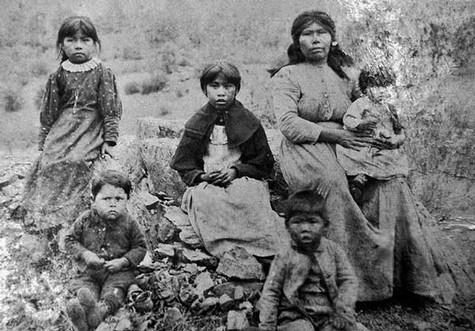
Late 1800s photo of the Miwok family
In 1851, the year after statehood, a total of 18 treaties were signed that reserved California lands for Miwok tribes. These treaties, as in the course of virtually all the treaties made with Native Americans, were never honored. Instead, most of the surviving Miwok were forced into reservations in Mendocino County, many in the Round Valley Reservation in the north part of the county. In 1906 those 1851 treaties were "rediscovered." Subsequently, 54 rancherias were established — including the Jackson Rancheria (1893), Tuolomne Rancheria (1910) Sheep Ranch Rancheria (1916), and Middletown Rancheria (1990) —and designated as federal lands for aboriginal settlement.
There is, still, a tribal or general council of Miwok that operates out of Shippee Lane in Stockton. According to Tribe Facts, most of the people with Miwok blood now live in Northern California towns or in the rancherias or small reservations. Other Miwok descendants live in intertribal communities such as Round Valley Reservation.
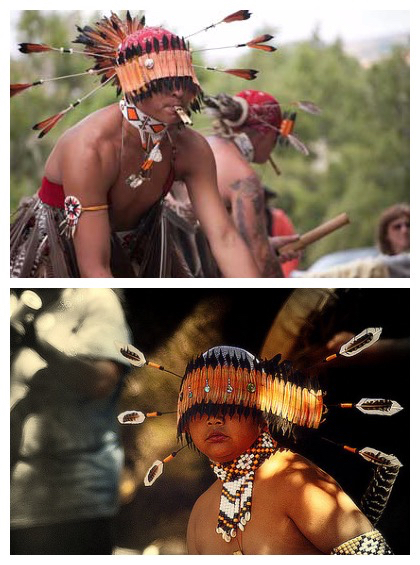
Modern-day demonstration of ceremonial Miwok attire (images courtesy of California Indians and The Miwok People of California)
Where you will not find people of Plains Miwok descent, it seems, is in their original homeland, which roughly corresponds with the Lodi Viticultural Area. That is, the areas designated as winegrowing regions between Sacramento and Stockton — falling within the northern part of San Joaquin County and the southern edges of Sacramento County — and also the eastern edges of the Delta region, just west of Interstate 5.
Going back to our original question about where the Plains Miwok have gone: By 1848, the Mokelumne River watershed area had been largely vacated by the native Plains Miwok population for several reasons, all of them devastating. First, there were the Spanish missionaries, who began baptizing Coast Miwok in 1794. By 1811 Plains Miwok began to be relocated, both voluntarily and forcibly, to the Franciscan order's Mission San José as well as to nearby ranches. Those who fled were rounded up by Spanish soldiers and forced into labor. There were, in fact, ongoing rebellions, and some of the Miwok became excellent horsemen, as horses obtained in raids only increased their ability to raid Spanish ranches. By the 1820s, it is also said, horsemeat became a staple of the Miwok diet.
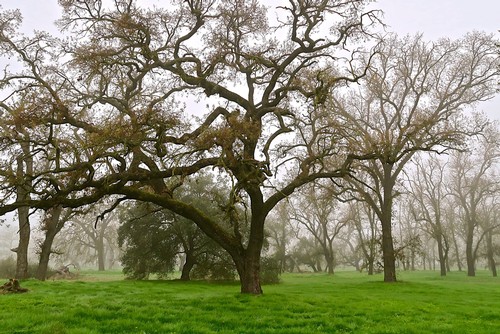
32-acre valley oak grove in Jessie's Grove, preserved to perpetually display the landscape prior to the start of farming in the Mokelumne River area
Within these forced and stressed environments, by the 1830s most of the Miwok had succumbed to waves of malaria, smallpox, and cholera epidemics. Even after Mexico won its independence from Spain in 1821, and the Alta California missions were secularized in 1838, the Miwok who managed to survive the missionaries and diseases fared no better at the hands of settlers and ranchers rushing up from Mexico. According to one source, one Mexican rancher was known to gather posses consisting of other ranchers to round up hundreds of more Miwok. Those who did not submit to enslaved labor were simply slaughtered.
John Sutter, who founded Sutter's Fort in 1841 in the area that became Sacramento, was said to have played off the few Plains Miwok families still living in their original homes against other groups to successfully gain control of their lands. At that point, many of the surviving Plains Miwok families chose to settle in or around the Bay Area, eventually intermarrying with other native groups (such as the Ohlone, Patwin, and Yokuts) or finding work on Mexican ranchos.
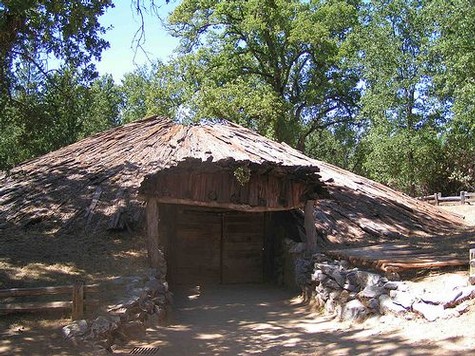
A modern-day replica of the Miwok pit home
According to Toni Christman in Our Time to Shine, “Swiss immigrant Mr. Magley was said to have planted the first [Lodi] vineyard in 1848 on Turner Road." The Lodi Historian newsletter has written that when Ezekial Lawrence, a pioneering Lodi farmer, arrived in Lodi in 1857, “there was less than 10 acres of grapes in San Joaquin County.” But once George West, with the help of his brother William West, established his Stockton-based El Pinal Winery in 1858 and began to contract Mokelumne River area farmers to plant grapes, the Lodi landscape that we know today was firmly established. Many of the families who established farms and ranches between the 1850s and 1880s, of course, are still farming in Lodi today, and also own successful wineries.
Even Northern, Central, and Southern Miwok tribes living in the foothills of the Sierra Nevada, who were largely unaffected by calamities inflicted by Spanish and Mexican settlers, were quickly decimated by contact with miners pouring in from across the country and around the world. Many of these Miwok worked hand in hand with miners, and a few prospected for gold themselves. But it's been documented that between 1847 and 1860 hundreds of Miwok were killed, and their lands seized, by unscrupulous miners and prospectors. Many were enslaved and forced to work in mines. The rest fell prey to the invariable diseases, and that other scourge of Native Americans introduced by the newcomers: alcohol.
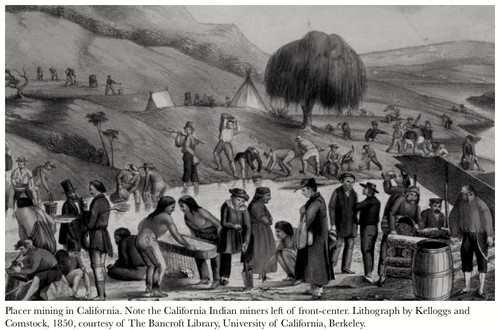
1850 lithograph showing Miwok working alongside Anglo miners in the Placer area
One final thing we know about the Plains Miwok in particular: They were by no means cut from a single cloth. Anthropologists have identified multiple tribes of Plains Miwok by separate village locations, which include:
• On the Cosumnes River — Chuyumkatat, Lulimal, Mayeman, Mokos-unni, Sukididi, Supu, Tukui, Yomit
• Near the Cosumnes River — Umucha, Yumhui
• On the Mokelumne River — Lel-amni, Mokel(-unni), Sakayak-unni
• On the east bank of Sacramento River below Sacramento — Hulpu-mni
• On Jackson Creek — Ochech-ak
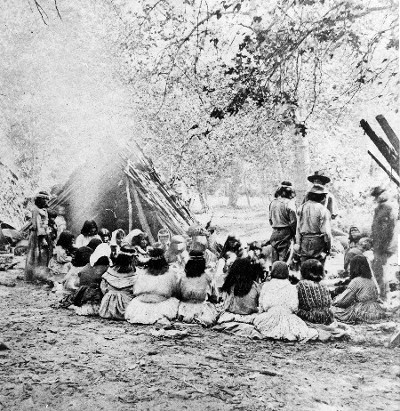
1872 photograph of Southern Miwok tribal council
Among the important landholding local tribes identified during the time of Spanish colonization of Alta California:
• Anizumne at Rio Vista on the west side of the Sacramento River
• Chilamne at Bellota on the Calaveras River
• Chucumne at Liberty Island on the west side of the Sacramento River
• Cosomne at the Wilton Rancheria Miwok on the Cosumnes River
• Gualacomne at Freeport on both sides of the Sacramento River
• Guaypemne at Terminus on the Mokelumne River delta
• Lelamne at Clements on the Mokelumne River
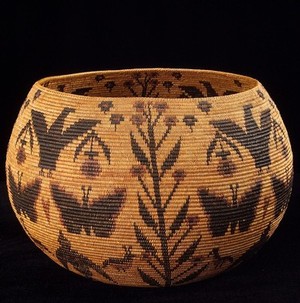
Central Miwok basket by native Mono Paiute artist Lucy Telles (image courtesy of genequintanafineart.com)
• Muquelemne at Ione on the Mokelumne River
• Musupum at Andrus Island at the confluence of the Mokelumne and San Joaquin rivers
• Ochejamne at Courtland on the east side of the Sacramento River
• Quenemsia at Grand Island among the distributary channels of the Sacramento River
• Seuamne at Jenny Lind on the Calaveras River (intermediate to Northern Sierra Miwok)
• Sonolomne probably on Dry and Laguna creeks east of Galt
• Unizumne at Thornton at the confluence of the Cosumnes and Mokelumne rivers
• Ilamne at Yolano on the west side of the Sacramento River (northwest of Freeport)
Sadly, all of these individual communities were long gone by the time the first settlers of European descent arrived at the end of the 1840s to establish their homesteads, farms, and ranches. But at least you now know they were once there.
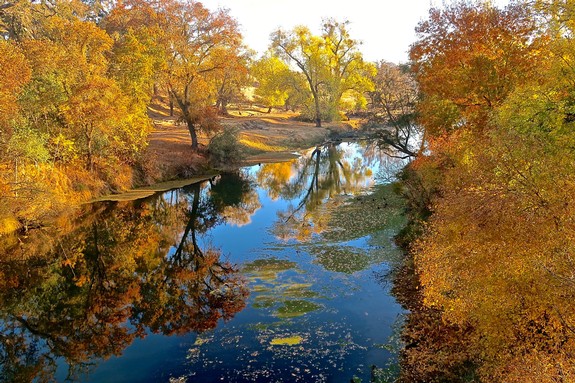
The Mokelumne River in Lodi's Clements Hills Viticultural Area